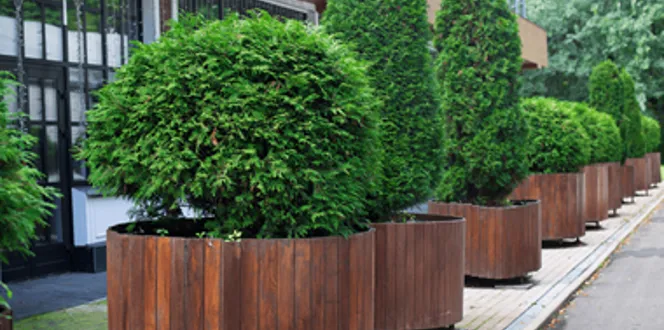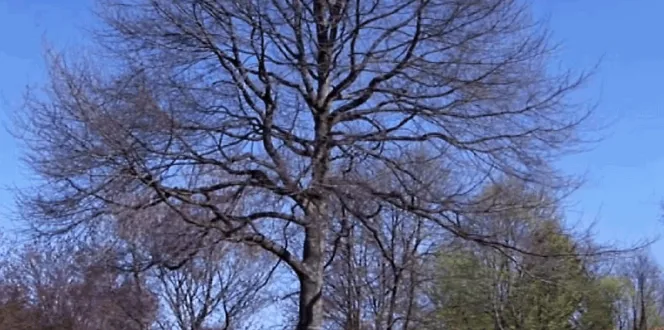You might wonder how often tree transplanting takes place in a tree’s life. It might seem like many are rooted in only one or two places their entire lives.
But in your residential landscape, most of the trees you plant have actually been transplanted several times throughout their lives.
Think about it. Many trees in a nursery may start as bare-root seedlings in a field or tubelings. Both types can be transplanted to the field for more space once or twice, or repotted to larger and larger pots several times before they are finally sold and installed in your landscape. After that, some trees are transplanted again if you decide they would be better in a different location, or if you make changes to your home or landscape that force you to move them.
But, just like any planting technique, there are ways to transplant trees properly to ensure they survive and continue to thrive.
Let’s dive into some reasons why you’d move one of your trees, some tree transplanting tips, as well as some mistakes to avoid.
When To Move A Tree
Each time a tree is moved, it’ll go through a period of stress and re-establishment. Every time your tree is moved, it will have to adapt to root loss and changes to its environment.
So, moving a tree too often would pile on the stress and potentially trigger a decline.
Also, the larger your tree, the less frequently you want to transplant it since it can take longer to recover from tree transplant shock.
Finally, tree species can make a huge difference in transplant stress tolerance. Some species will be more tolerant to tree transplanting than others.
In fact, it takes a tree one year to recover for every inch of its diameter at breast height (DBH). This time enables the tree to fully recover its root system. To give you an example, a 3-inch diameter tree that has been moved will need at least 3 years in the ground to become fully re-established.
As such, follow this rule when it comes to transplant frequency: Transplant a tree no more frequently in years than its DBH in inches.
Common Tree Transplanting Mistakes
Most trees will transplant to a new location well, as long as they receive proper care before, during, and after the process. Regular maintenance is essential in getting your tree to recover.
But there are some common mistakes you should avoid when moving trees:
- Wrong tree, wrong place - You always want to choose a tree that is well-suited to your region’s hardiness zones, sun exposure, and soil conditions.
- Poor root system - For every inch of tree diameter, there should be 10 to 12 inches of root ball diameter; anything smaller will exacerbate tree transplant shock.
- Poor planting location - Match your tree species to your soil pH, volume, and moisture, and amend your soil if it needs improvement. Also check the drainage at your planting location. If it’s a low spot or holds more moisture, you will want to choose a moisture-tolerant species.
- Inadequate planting hole - Planting your tree right requires the right size hole. It should be twice the width of the root ball so you allow newly-developing roots to establish themselves and grow.
- Planting too deep - Your planting hole shouldn't be deeper than your root ball. The root collar should rest 1-2 inches above the soil grade once the tree has been planted and settled.
- Improper mulching - Mulch has a lot of benefits, including suppressing weeds and preserving soil moisture. Too little mulch won’t provide these benefits, and too much mulch will build-up on the trunk and cause rot.
- Improper watering - Too much water can suffocate your tree’s roots; but too little water will result in root death from desiccation. Soaking the root zone thoroughly once per week, and allowing the water to drain-out in between without allowing the soil to become dusty dry, will strike the right balance.
Why You Should Hire A Certified Arborist
Tree relocation, especially when you’re moving a large tree, can be very tricky to get right.
A certified arborist can help in this process. They have the knowledge of tree species and needs and can apply the correct techniques to ensure success, as well as provide you with tips on the tree’s much needed aftercare.
For large trees especially, consulting with and hiring a certified arborist with the right equipment to support the tree’s size and weight can ensure your investment suffers minimal damage and thrives in its new location.
Tips On How To Successfully Transplant A Tree
Just like there are some things to avoid when it comes to tree transplanting, there are also some tips to ensure success.
- The ideal time to transplant a tree is when it’s dormant and the ground conditions are good (moderate moisture, and soil that’s not frozen). In autumn this is after leaf fall and before the soil freezes solid, and in spring, this is after the soil thaws and before the tree begins to sprout new leaves.
- Consider your tree’s future growth when choosing it’s planting location. The potential tree height and size, and the location of utility lines, buildings, underground utilities, your home foundation, and driveways or sidewalks can impact your tree species choice.
- Prepare your planting site well. Perform a soil test, adjust pH if necessary, break up soil compaction around the planting area, and add organic matter to the soil.
- Hydrate your tree well before it’s transplanted.
- Tie the crown or gently wrap the tree in a tarp to reduce limb breakage, wind damage, and moisture loss during transport if moving it off site
- Provide your tree with a proper mulch ring that extends 3 feet beyond its drip line.
- Don’t forget to water your tree right after transplanting and then again on a regular basis to maintain soil moisture. This usually equates to about 1 inch of water per week.





